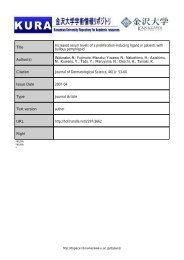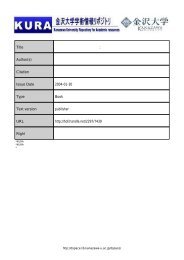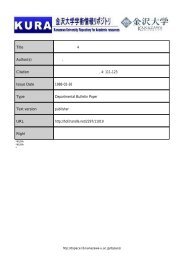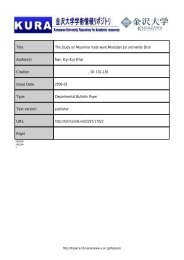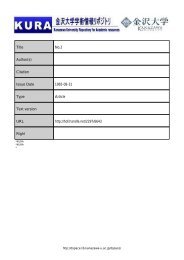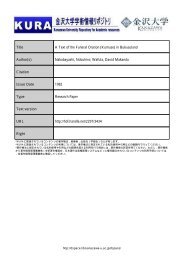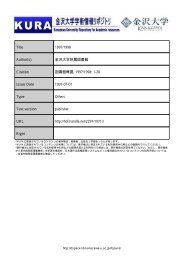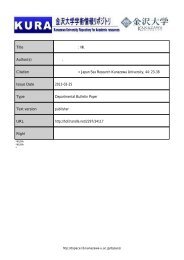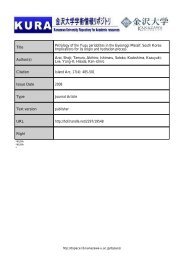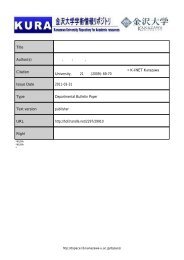Title Petrological feature of spinel lherzolite xenolith from Oki-Dogo ...
Title Petrological feature of spinel lherzolite xenolith from Oki-Dogo ...
Title Petrological feature of spinel lherzolite xenolith from Oki-Dogo ...
Create successful ePaper yourself
Turn your PDF publications into a flip-book with our unique Google optimized e-Paper software.
Table 1 Modal compositions <strong>of</strong> <strong>spinel</strong> <strong>lherzolite</strong> <strong>xenolith</strong>s <strong>from</strong> <strong>Oki</strong>-<strong>Dogo</strong><br />
<strong>Oki</strong>-<strong>Dogo</strong> Island <strong>spinel</strong> <strong>lherzolite</strong> <strong>xenolith</strong> 223<br />
Ol Opx Cpx Sp Fo Cr# T (Wells) T (S & S)<br />
KRB 2 60.4 30.2 4.0 2.4 86.8 0.065 1054 1032<br />
KRB 3 54.8 37.5 6.8 1.2 87.2 0.260 1017 1099<br />
KRB 4–1 82.5 15.3 0.7 1.4 86.4 0.158 1050 1088<br />
KRB 4–2 71.7 17.2 1.9 9.2 89.7 0.141 1057 1115<br />
KRB 5 62.8 27.6 6.6 3.1 89.8 0.192 1046 1092<br />
KRB 6 58.8 28.6 9.7 2.9 88.9 0.190 1032 1145<br />
KRB 9 48.9 45.0 3.5 2.4 87.0 0.178 1060 1193<br />
KRB t-1 46.2 42.6 8.4 2.8 87.6 0.160 1066 1196<br />
KRB t-2 80.1 10.9 8.7 0.3 88.5 0.186 1034 1068<br />
KRB t-3 50.2 44.2 4.1 1.3 87.9 0.187 1040 1179<br />
Average Fo content <strong>of</strong> olivine (Fo) and Cr/(Cr + Al) atomic ratio (Cr#) in each sample are shown. The equilibrium temperatures (∞C) are<br />
calculated by Wells (1977) two pyroxene geothermometer and Sachtleben and Seck (1981) Al in Opx geothermometer for T (Wells) and T (S<br />
& S), respectively. Ol, olivine; Opx, orthopyroxene; Cpx, clinopyroxene, Sp, <strong>spinel</strong>.<br />
Fig. 4 Modal compositions <strong>of</strong> olivine, orthopyroxene and clinopyroxene<br />
in the samples. As a comparison, the data <strong>of</strong> subarc mantle <strong>xenolith</strong>s<br />
(data <strong>from</strong> Abe 1997) and highly metasomatized peridotite <strong>from</strong> Ichinomegata,<br />
North-east Japan arc (Abe et al. 1992) are shown. <strong>Oki</strong>-<strong>Dogo</strong> <strong>spinel</strong><br />
<strong>lherzolite</strong> has a small amount <strong>of</strong> clinopyroxene compared with hightemperature-type<br />
peridotite <strong>xenolith</strong>s <strong>from</strong> South-west Japan arc (shaded<br />
area; data <strong>from</strong> Abe 1997). ( ), Megata highly metasomatized<br />
(amph. > 10 vol%); (), megata (others); () Kurose; (), KRB-4-2;<br />
(▼), KRB-9; (), KRB-t-1; ( ), <strong>Oki</strong>-<strong>Dogo</strong> (others).<br />
spectrometer JEOL 8800 superprobe at Tokyo<br />
Institute <strong>of</strong> Technology, using a focused beam, and<br />
an accelerating voltage <strong>of</strong> 15 KeV and a beam current<br />
<strong>of</strong> 12 nA on all phases. The structural formula<br />
<strong>of</strong> <strong>spinel</strong> was calculated assuming the <strong>spinel</strong> stoichiometry<br />
after subtracting all Ti as an ulvo<strong>spinel</strong><br />
component (Fe 2 TiO 4 ). Total Fe in silicate analysis<br />
was assumed to be Fe 2+ . Selected microprobe analyses<br />
are listed in Table 2.<br />
The Fo content <strong>of</strong> olivine ranges <strong>from</strong> 86.5 to<br />
89.8, and is lower than that in most other mantle<br />
<strong>xenolith</strong>s <strong>from</strong> the Japan arcs (Fig. 5). The NiO<br />
content <strong>of</strong> olivine is, however, rather constant,<br />
being approximately 0.3 wt% (0.25–0.36) and has a<br />
Fig. 5 Relationships between the Fo content <strong>of</strong> olivine and the Cr/<br />
(Cr + Al) atomic ratio (Cr#) <strong>of</strong> <strong>spinel</strong> <strong>from</strong> <strong>Oki</strong>-<strong>Dogo</strong> <strong>spinel</strong> <strong>lherzolite</strong><br />
<strong>xenolith</strong>s. Spinel and plagioclase peridotites data are <strong>from</strong> Takahashi<br />
(1978a) and Abe et al. (1999). The data <strong>of</strong> other peridotite <strong>xenolith</strong>s <strong>from</strong><br />
Japan arcs (Abe 1997; Arai et al. 2000), highly metasomatized peridotite<br />
<strong>xenolith</strong>s <strong>from</strong> Ichinomegata (Abe et al. 1992) and harzburgite <strong>from</strong><br />
Oshima-Oshima (Ninomiya & Arai 1992) and the Japan Sea floor (Ishii<br />
1987) are shown for comparison. Olivine–<strong>spinel</strong> mantle array (OSMA) is<br />
a <strong>spinel</strong> peridotite restite trend after Arai (1987, 1994a). (), Oshima-<br />
Oshima; (★), Japan Sea; ( ), Megata highly metasomatized<br />
(amph. > 10 vol%); (), Megata (harz. (harzburgite) with hornblendite<br />
veinlet); (), Megata (others); (), KRB-4-2; (▼), KRB-9; (), KRB-t-1;<br />
( ), <strong>Oki</strong>-<strong>Dogo</strong> (others).<br />
slightly but distinctly positive correlation with Fo<br />
content (Table 2).<br />
The Cr# (= Cr/(Cr + Al)) <strong>of</strong> <strong>spinel</strong> is low (0.06–<br />
0.26; Fig. 5) and the Mg# (= Mg/(Mg + Fe 2+ )) <strong>of</strong><br />
<strong>spinel</strong> has a negative correlation with the Cr#. The<br />
TiO 2 content in <strong>spinel</strong> is slightly higher than that in<br />
abyssal <strong>spinel</strong> peridotite at a given Cr# (cf. Dick &<br />
Bullen 1984). The Fe 3+ /(Cr + Al + Fe 3+ ) ratio is




